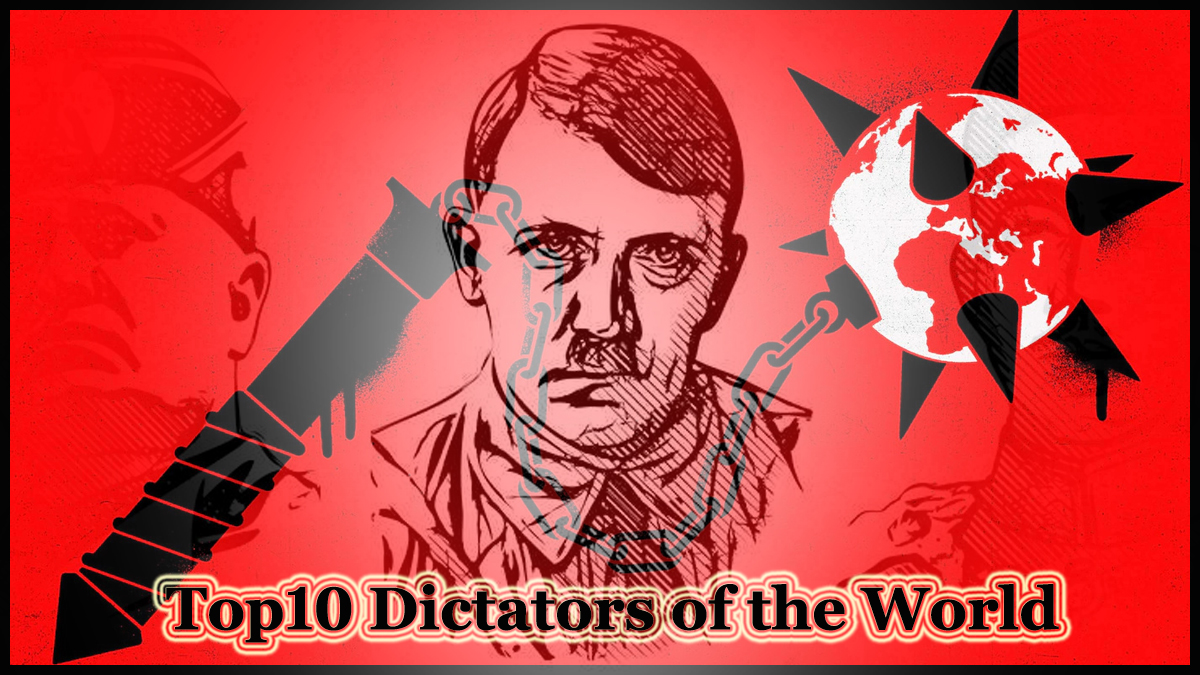
Top10 Dictators of the World: The term “dictator” is derived from the Latin word “dicttor,” which is an agent noun from the verb “dictare” (dictt-, past participial stem of “dictare”; dictate v. + -or -or suffix). A judge who was given temporary absolute power in the Roman Republic was referred to as a dictator in Latin. In a dictatorial system, the head of state is typically referred to as the “dictator,” even though their official title may more closely approximate anything akin to “leader.”
However, based on historical significance, the number of people affected, and the impact of their actions, some of the most well-known dictators in history include:
Top10 Dictators of the World
- Adolf Hitler (Germany)
- Joseph Stalin (USSR)
- Mao Zedong (China)
- Pol Pot (Cambodia)
- Saddam Hussein (Iraq)
- Kim Jong-il (North Korea)
- Bashar al-Assad (Syria)
- Idi Amin (Uganda)
- Muammar Gaddafi (Libya)
- Nicolae Ceaușescu (Romania)
It’s important to note that these individuals and their regimes were responsible for causing widespread suffering, death, and destruction. Additionally, this list is not intended to glorify their actions, but rather to acknowledge their historical significance.
1. All about Adolf Hitler (Germany)
Adolf Hitler was the leader of the Nazi Party and Chancellor of Germany from 1933 to 1945. He rose to power in the aftermath of World War I, during a time of economic and political instability in Germany. Hitler was appointed Chancellor in 1933 and quickly consolidated his power, using propaganda and terror to silence opposition and establish a dictatorship. In 1934, he became Führer (leader) of Germany, a title he held until his death.
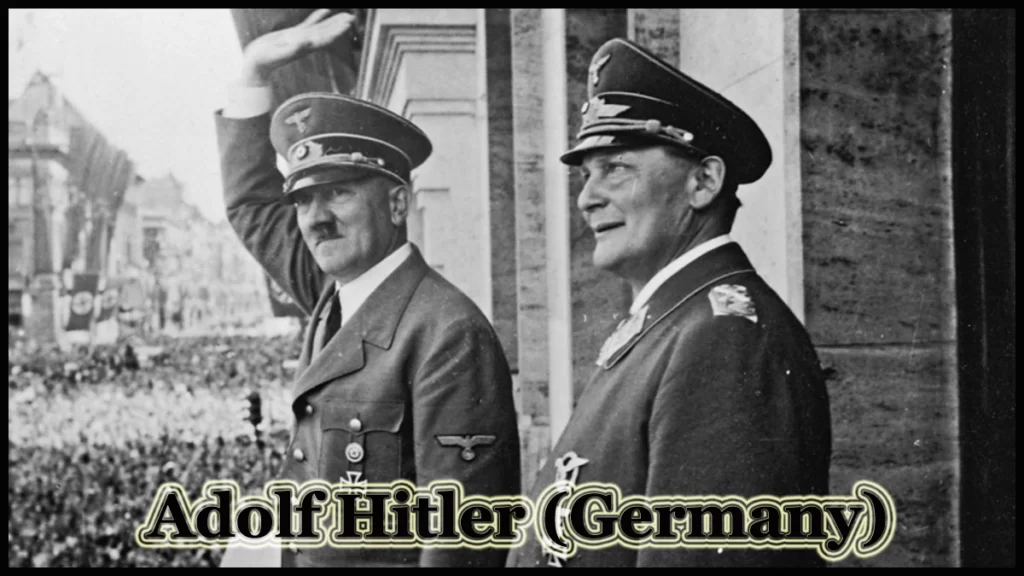
Top10 Dictators of the World
Hitler’s regime is most commonly associated with the Holocaust, the systematic extermination of six million Jews and other minority groups such as Romani, disabled, and LGBTQ individuals. The Holocaust was one of the most horrific episodes of human history, and Hitler’s role in it has made him a symbol of evil.
Hitler’s foreign policy, known as Lebensraum (living space), aimed to acquire new territories in Eastern Europe for German settlement and to secure the country’s position as a world power. This ultimately led to the outbreak of World War II in 1939. Hitler’s military strategy was initially successful, with the rapid conquest of much of Europe, but ultimately proved to be his downfall. By 1945, the Allies had defeated Germany and Hitler committed suicide in his bunker in Berlin as the Soviet army closed in on the city.
Hitler’s impact on world history is immense and largely negative. He is widely regarded as one of the most evil people to have ever lived, and his actions as a dictator caused widespread death and destruction. The memory of the Holocaust and World War II continues to shape international relations and serves as a warning against the dangers of fascism and tyranny.
Here’s some additional information about Adolf Hitler:
Early life: Hitler was born in Austria in 1889. He moved to Germany in 1913 and joined the German army during World War I. After the war, he became involved in politics and joined the National Socialist German Workers’ Party, better known as the Nazi Party.
Rise to power: Hitler rose to power in the early 1930s by capitalizing on the dissatisfaction and anger of the German people following World War I and the economic crisis of the time. He used his charisma, propaganda, and the promise of a better future to gain support and ultimately seize power.
Ideology: Hitler’s ideology was based on the concept of racial superiority and the belief that the Aryan race was superior to all others. This belief formed the basis of his policies and led to the systematic extermination of millions of people during the Holocaust.
Legacy: Hitler’s legacy is one of terror, cruelty, and evil. His actions during the Holocaust continue to impact the world and are widely regarded as some of the most horrific events in human history. His legacy serves as a warning against the dangers of fascism and tyranny.
Personal life: Hitler was known to have had a vegetarian diet and was a teetotaler. He was a personal friend of and supporter of the arts, including architecture, music, and painting. Hitler was also a fan of the opera and was known to have attended many performances. He was married to Eva Braun, with whom he committed suicide in his bunker in Berlin in 1945.
2. All about Joseph Stalin (USSR)
Joseph Stalin was a Soviet politician who led the Soviet Union from the mid-1920s until his death in 1953. He served as both General Secretary of the Communist Party of the Soviet Union (1922–1952) and Premier of the Soviet Union (1941–1953).
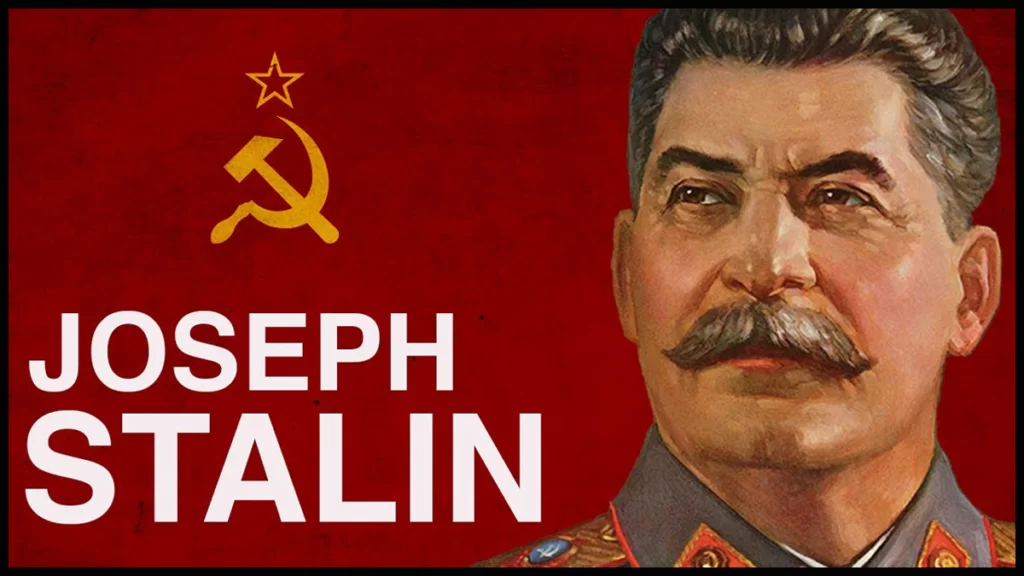
Stalin was born on December 18, 1878, in Gori, Georgia, which was then part of the Russian Empire. He joined the Bolshevik party, which later became the Communist Party of the Soviet Union, in 1903 and became one of its leading members. He played a major role in the Bolshevik Revolution of 1917 and the subsequent Civil War, which ended in 1923 with the defeat of the anti-Bolshevik forces.
Top10 Dictators of the World
After Lenin’s death in 1924
After Lenin’s death in 1924, Stalin emerged as the leader of the Soviet Union and began to implement his policies of industrialization and collectivization. These policies resulted in the rapid industrialization of the country but also caused widespread famine, particularly in the Ukraine, which is estimated to have resulted in the deaths of millions of people.
Stalin also implemented a policy of political repression, known as the Great Purge, which resulted in the arrest, execution, or banishment to labor camps of hundreds of thousands of people, including many members of the Communist Party and military. This period of repression is widely considered to be one of the greatest human rights abuses of the 20th century.
Despite the brutal tactics used by Stalin to maintain his grip on power, he is also credited with leading the Soviet Union to victory in World War II, and with overseeing the development of the country into a major industrial and military power.
Stalin died on March 5, 1953, of a stroke. His legacy is highly controversial and remains the subject of much debate. While some see him as a ruthless dictator who was responsible for widespread repression and the deaths of millions of people, others view him as a strong leader who modernized the Soviet Union and made it into a major world power.
Here’s some more information about Joseph Stalin:
Ideology: Stalin was a Marxist-Leninist and a strong advocate of the ideas of Karl Marx and Vladimir Lenin. He believed in the principles of communism and the dictatorship of the proletariat, and he saw the Soviet Union as a model for other socialist states around the world.
Foreign policy: Stalin was a key player in the international Communist movement and was involved in supporting Communist movements and parties around the world. He was also involved in the formation of the Communist bloc in Eastern Europe after World War II, and he played a key role in the establishment of the Cominform and the Comintern.
Cultural policies: Stalin was known for his cultural policies, which included the promotion of Socialist Realism in the arts, the repression of independent artists and writers, and the creation of a cult of personality around himself. He also encouraged the development of a new Soviet culture that was distinct from traditional Russian culture.
Some more information about Joseph Stalin
Succession: After Stalin’s death, there was a power struggle between his top lieutenants, including Nikita Khrushchev, who eventually emerged as the leader of the Soviet Union. Khrushchev’s policies of de-Stalinization, which included the rehabilitation of many of those who had been purged during Stalin’s rule, marked a major turning point in Soviet history.
Legacy: Stalin’s legacy continues to be controversial, with some regarding him as a monster who was responsible for widespread repression, famine, and human rights abuses, while others view him as a great leader who modernized the Soviet Union and made it into a major world power. His name is still a source of debate and division in Russia, and opinions about him are often closely tied to larger debates about the legacy of communism and the Soviet era.
3. All about Mao Zedong (China)
Mao Zedong was a Chinese communist revolutionary who was the founding father of the People’s Republic of China (PRC), which he ruled as the Chairman of the Communist Party of China from its establishment in 1949 until his death in 1976.
Mao was born in 1893 in the small village of Shaoshan, in Hunan province, China. He was trained as a teacher and went on to study in Beijing, where he was exposed to Marxist ideas. In 1921, he joined the Communist Party of China and took part in the Chinese Civil War, which ended in 1949 with the defeat of the Nationalists and the establishment of the PRC.
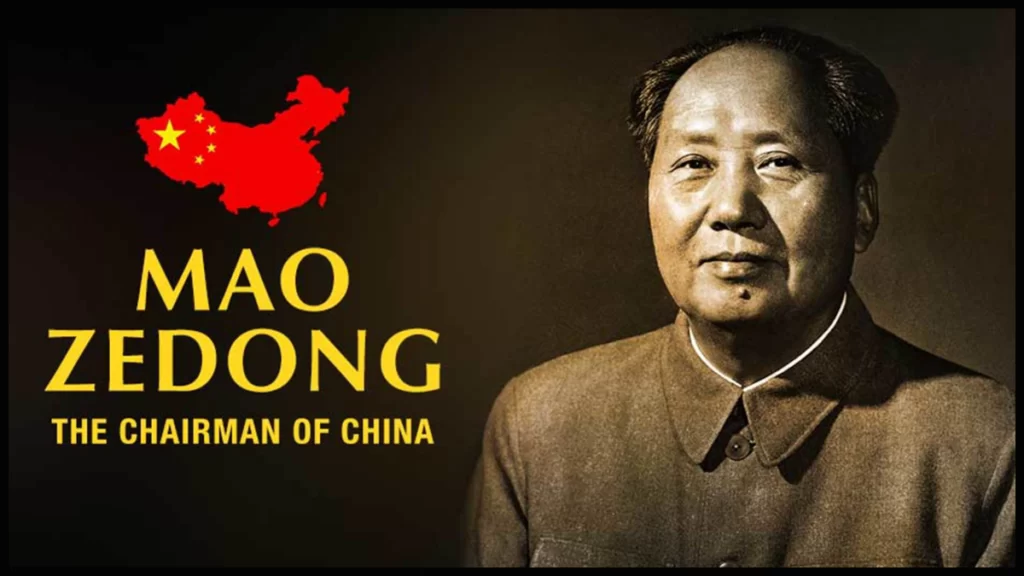
Top10 Dictators of the World
As the leader of the Communist Party and the PRC, Mao implemented a number of policies aimed at transforming China into a modern, socialist society. One of his most famous and controversial policies was the Great Leap Forward, a program launched in 1958 that aimed to rapidly industrialize the country and increase agricultural productivity. The program was a failure, leading to widespread famine and economic collapse.
Mao’s later years were characterized by political turmoil and purges, as he attempted to maintain his grip on power and purge those who he saw as threats to his rule. He is also known for the Cultural Revolution, a period of intense political and social upheaval that took place from 1966 to 1976, and was aimed at purging capitalist and traditional elements from Chinese society. The Cultural Revolution had a profound impact on China and caused widespread suffering and social disruption.
Despite his controversial policies and the widespread suffering they caused, Mao remains a revered figure in China, and his image and ideology continue to influence Chinese politics and society. He is widely regarded as one of the most important and influential leaders in Chinese history.
Here are some additional details about Mao Zedong’s life and legacy:
Ideology: Mao was a strong advocate of Marxist-Leninist ideology and believed in the power of the working class to bring about social change. He also believed in the importance of revolution and the use of violence to achieve political goals. His ideas on guerrilla warfare, known as “People’s War,” have been widely studied and are considered to have had a significant impact on the development of modern guerrilla tactics.
Literary Works: Mao was also a prolific writer and poet. His most famous work is the “Little Red Book,” which contains his selected thoughts and speeches. The book was widely distributed during the Cultural Revolution and remains an important part of Mao’s legacy.
Relations with the Soviet Union: Mao had a complex relationship with the Soviet Union, the world’s other major communist power. At times, the two countries were close allies, but they also had major differences and at times openly clashed. Mao was critical of the Soviet Union’s leadership and believed that it had strayed from true Marxist-Leninist principles.
Mao Zedong’s life and legacy
Foreign Policy: Mao was a major figure in the development of Chinese foreign policy and is widely regarded as one of the most important leaders in the history of the non-aligned movement. He sought to build strong relationships with countries in the developing world and was a vocal critic of Western imperialism.
Legacy: Mao’s legacy is a subject of ongoing debate and discussion. On one hand, he is credited with reunifying China and establishing it as a major world power. On the other hand, his policies, such as the Great Leap Forward and the Cultural Revolution, are widely criticized for causing widespread suffering and economic collapse. Nevertheless, Mao remains a controversial and highly influential figure in Chinese history and politics.
In conclusion, Mao Zedong was a complex and influential figure who left a lasting impact on China and the world. His ideas and policies continue to be studied and debated, and his legacy remains a subject of ongoing discussion and interpretation.
4. All about Pol Pot (Cambodia)
Pol Pot was the former leader of the Communist Party of Kampuchea, also known as the Khmer Rouge, in Cambodia. He served as the Prime Minister of Cambodia from 1976 to 1979.
Pol Pot was born as Saloth Sar in 1925 in Cambodia. He was educated in France and became a Marxist-Leninist. After returning to Cambodia, he joined the Communist Party and became a key leader in the party’s resistance against the government.
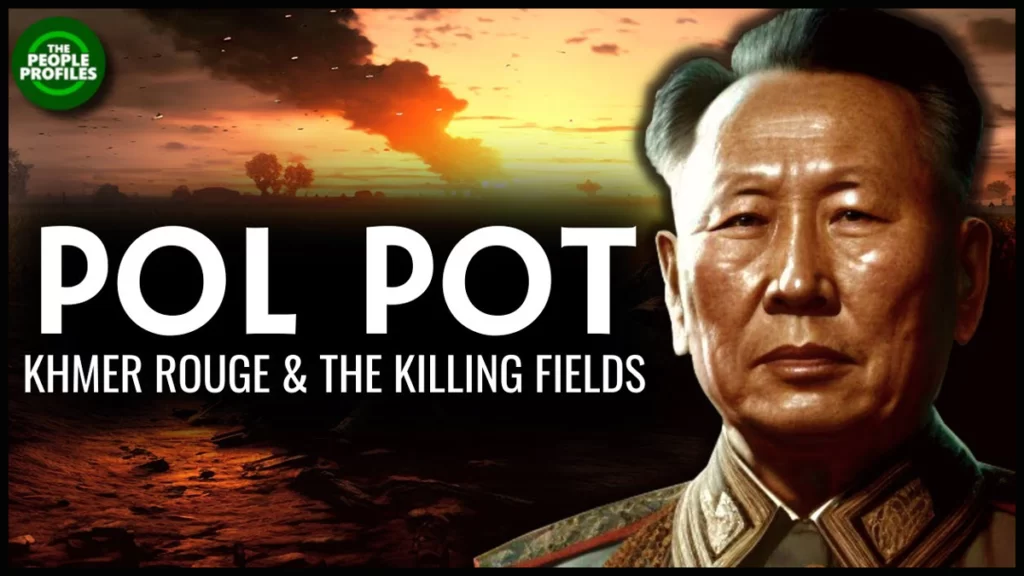
In 1975, the Khmer Rouge, under the leadership of Pol Pot, came to power in Cambodia after overthrowing the government in a violent revolution. They implemented a brutal regime that aimed to create a classless, agrarian society by forcibly relocating millions of people from cities to rural areas and eliminating those who were seen as threats to the regime.
Top10 Dictators of the World
The Khmer Rouge regime was marked by widespread human rights abuses, including forced labor, starvation, and mass executions. It is estimated that between 1.5 and 2 million people, or roughly a quarter of Cambodia’s population, died as a result of the Khmer Rouge’s policies.
Pol Pot was overthrown in 1979 by Vietnamese forces, and he went into hiding in Cambodia and Thailand. He continued to lead the Khmer Rouge insurgency until his arrest in 1997. He died in 1998 while under house arrest in Cambodia.
The legacy of Pol Pot and the Khmer Rouge continues to shape Cambodia today. The country has struggled to come to terms with the horrors of the past and to provide justice for the victims of the regime. The legacy of Pol Pot serves as a reminder of the terrible consequences of political extremism and the importance of promoting human rights and democratic values.
Here’s more information about Pol Pot and the Khmer Rouge:
Trials for crimes committed during the Khmer Rouge regime: In the years following the fall of the Khmer Rouge, there was international pressure for those responsible for the atrocities committed during the regime to be held accountable. In 1997, a tribunal was established to try the top leaders of the Khmer Rouge. However, it was not until more than two decades later, in 2009, that the first trial took place. Four senior leaders of the Khmer Rouge, including “Brother Number Two” Nuon Chea, were eventually convicted and sentenced to life in prison.
Political ideology: The Khmer Rouge regime was characterized by an extreme form of Marxist-Leninist ideology, which advocated for a radical restructuring of society. The regime sought to create a pure, agrarian society free of Western influence, and viewed urban areas and intellectuals as sources of contamination. This led to the mass evacuation of people from cities and the execution of anyone perceived as a threat to the regime.
Pol Pot and the Khmer Rouge
The Killing Fields: The term “Killing Fields” refers to the mass graves and execution sites that were used by the Khmer Rouge to dispose of their victims. Today, many of these sites serve as memorials to commemorate the victims of the regime. The Killing Fields have become symbols of the atrocities committed by the Khmer Rouge, and they serve as a reminder of the importance of promoting human rights and preventing similar atrocities from occurring in the future.
Cultural impact: The Khmer Rouge regime had a profound impact on Cambodian culture and society. Many Cambodians were traumatized by the events of the regime, and the country has struggled to rebuild in the decades since the fall of the Khmer Rouge. The regime’s attempts to eliminate religion, culture, and tradition had a lasting impact on the country, and many families were torn apart by the violence and suffering of the period.
Overall, the legacy of Pol Pot and the Khmer Rouge continues to have a profound impact on Cambodia and the world. The events of the regime serve as a warning of the dangers of extremist ideologies and the importance of promoting human rights and accountability.
5. All about Saddam Hussein (Iraq)
Saddam Hussein was the fifth President of Iraq, serving in this role from 1979 until 2003. He was born in Tikrit, Iraq, on April 28, 1937. Hussein was one of the most controversial figures in modern Middle Eastern history, and his rule was characterized by an authoritarian and oppressive regime.
Hussein came to power in 1979, after a period of political turmoil in Iraq. He quickly consolidated his power, purging potential rivals and establishing a one-party state. During his rule, he used a combination of violence and propaganda to maintain control over the country. He also launched wars against Iran and Kuwait, which resulted in significant loss of life and damage to the country’s infrastructure.
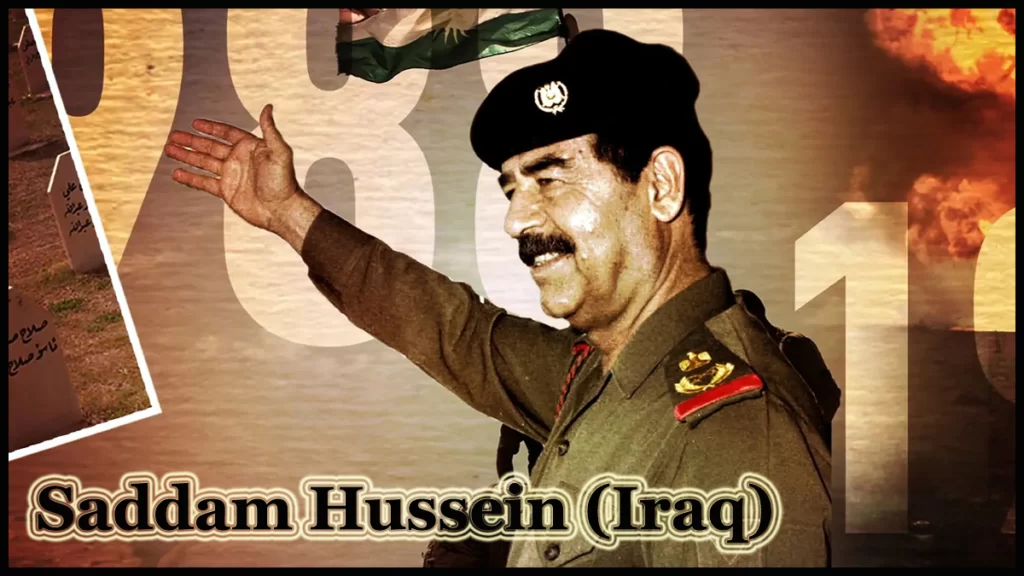
Top10 Dictators of the World
Hussein was known for his brutal tactics, including the use of chemical weapons against his own people. He also implemented policies that resulted in widespread human rights abuses, including arbitrary detention, torture, and execution of political opponents and others perceived as a threat to his rule.
In 2003, the United States, with the support of a coalition of other countries, invaded Iraq and toppled Hussein’s regime. He was captured by US forces in December of that year, and he was put on trial by the new Iraqi government. In 2006, he was found guilty of crimes against humanity and was sentenced to death by hanging. He was executed on December 30 of that year.
Hussein’s legacy in Iraq and the wider region remains a highly divisive and controversial issue. Some view him as a brutal dictator who oppressed and murdered countless numbers of people, while others see him as a strong leader who stood up to foreign powers and protected Iraq’s independence and sovereignty.
Here are a few more details about Saddam Hussein and his rule in Iraq:
Domestic policies: In addition to his brutal tactics and widespread human rights abuses, Hussein also implemented a number of domestic policies that had significant impacts on the Iraqi people. For example, he implemented a system of food rations that was intended to provide basic necessities to the population, but that also helped to maintain control over the population by tying them to the government. He also launched a series of massive construction projects, including the building of new cities and the expansion of existing ones.
Relations with the West: Hussein’s relationship with the West was marked by tension and conflict. He was widely regarded as a destabilizing force in the region, and his pursuit of weapons of mass destruction was a major concern for the international community. In 1990, he invaded Kuwait, which led to a military response from a coalition of countries led by the United States. The subsequent Gulf War resulted in significant damage to Iraq’s infrastructure and the deaths of many Iraqi civilians.
Legacy in Iraq: The aftermath of Hussein’s rule has had a profound impact on Iraq. The country has struggled to establish stability and rebuild in the years since his fall from power. The US-led invasion and subsequent occupation of Iraq also had far-reaching consequences, including the rise of sectarian violence and the emergence of extremist groups such as Al-Qaeda in Iraq and later, the Islamic State of Iraq and Syria (ISIS).
International views: Saddam Hussein remains a highly controversial figure internationally, and opinions about him vary widely depending on one’s political and cultural background. Some view him as a brutal dictator who deserves to be remembered for his crimes, while others see him as a hero who stood up against foreign powers and defended his country’s independence.
6. All about Kim Jong-il (North Korea)
Kim Jong-il was the supreme leader of North Korea from 1994 until his death in 2011. He was the son of North Korea’s founding leader, Kim Il-sung, and succeeded his father as the head of the country’s ruling Workers’ Party and the armed forces.
Kim Jong-il was known for his cult of personality, with the North Korean state promoting him as a near-deity and a brilliant military strategist and political leader. He was also known for his hard-line stance on North Korean security and his pursuit of nuclear weapons, which led to tensions with the international community.
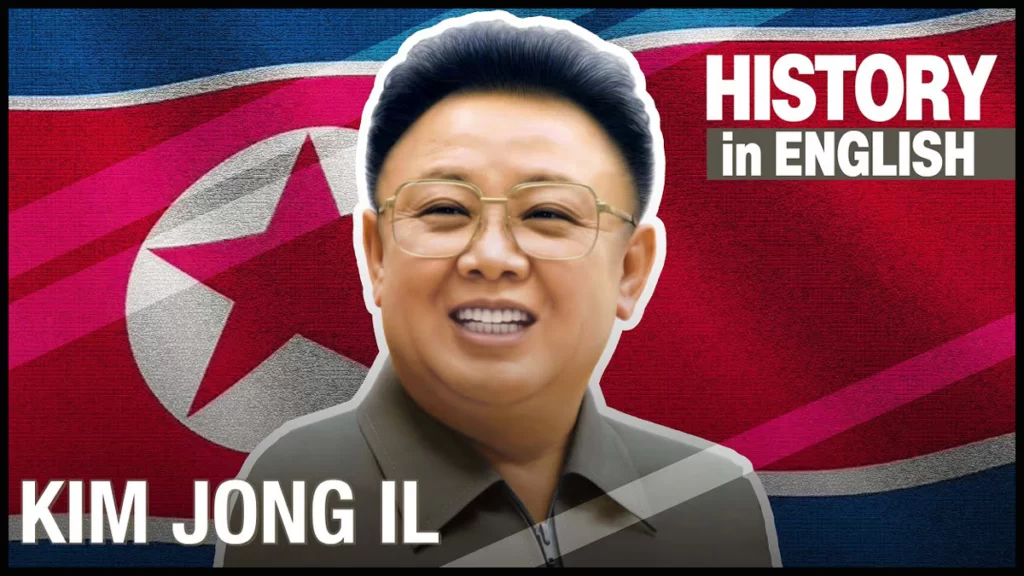
Top10 Dictators of the World
Under Kim Jong-il’s leadership, North Korea experienced a period of economic decline and widespread famine, which was partly the result of the country’s closed and heavily centralized economy. Despite this, he continued to maintain a tight grip on power, suppressing dissent and limiting contact with the outside world.
Kim Jong-il died on December 17, 2011, reportedly from a heart attack while on a train trip. He was succeeded by his son, Kim Jong-un. Despite his controversial legacy, Kim Jong-il remains a significant figure in North Korean history and is widely remembered by the North Korean people as a great leader.
here is more information about Kim Jong-il:
Education and Early Career: Kim Jong-il was educated in the Soviet Union, where he studied politics and economics. He began his political career in the late 1960s and was appointed to several key posts in the Workers’ Party and the government, where he was responsible for overseeing the country’s propaganda and cultural industries.
Domestic Policy: Kim Jong-il implemented a number of policies aimed at consolidating his power and strengthening the role of the state in North Korean society. He also established a cult of personality around himself, with the state media portraying him as a brilliant and charismatic leader who was loved by all North Koreans.
Foreign Policy: Kim Jong-il pursued a foreign policy that emphasized North Korea’s independence and self-reliance. He was a strong advocate of the country’s nuclear weapons program and sought to negotiate with the international community from a position of strength. He also maintained close ties with countries such as China and Russia, which provided political and economic support to North Korea.
Personal Life: Kim Jong-il was known for his love of luxury and his eccentric lifestyle, which included a personal train, a private yacht, and a collection of luxury cars. He was also known to be a fan of Western movies and had a large personal film collection.
Legacy: Kim Jong-il’s legacy is controversial and remains the subject of much debate. While he is remembered by the North Korean state as a great leader and a brilliant strategist, he is widely criticized by the international community for his human rights record and his pursuit of nuclear weapons. Nevertheless, his death in 2011 marked the end of an era in North Korean history and set the stage for his son’s rule.
7. Bashar al-Assad (Syria)
Bashar al-Assad is the current President of Syria, having taken office in July 2000, following the death of his father, Hafez al-Assad. He has been in power for over two decades and has faced widespread criticism and international sanctions for his handling of the Syrian Civil War, which began in 2011 as a popular uprising against his government and has since escalated into a complex and devastating conflict. The United Nations and numerous human rights organizations have documented widespread human rights abuses and war crimes committed by both the Syrian government and opposition forces. Despite this, al-Assad has maintained his grip on power and his government has been able to recapture much of the territory that was lost during the early years of the conflict, with the help of military support from allies such as Russia.
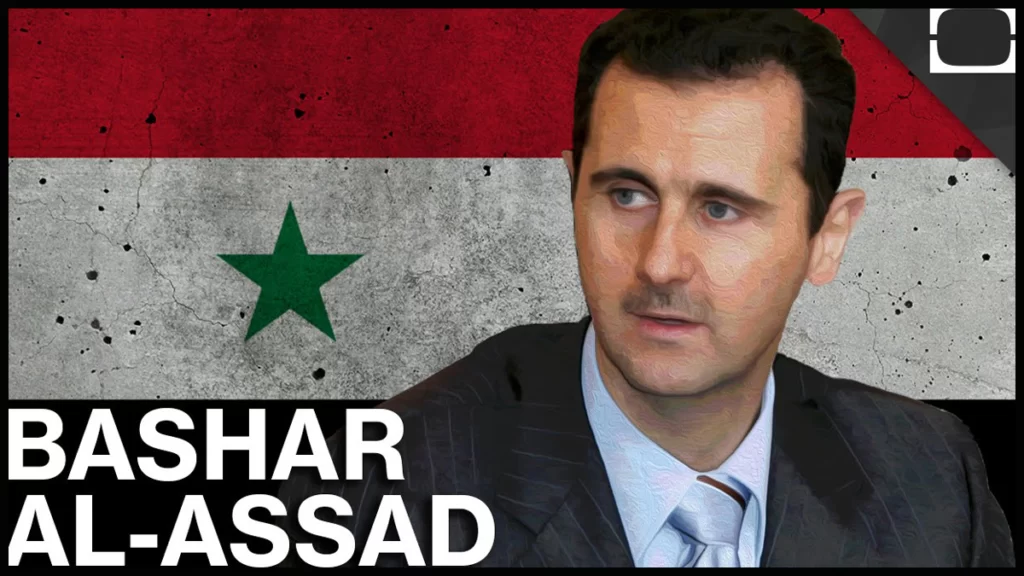
Bashar al-Assad was born on September 11, 1965, in Damascus, Syria. Before assuming the presidency, he trained as an ophthalmologist and worked in the medical field. He was seen as a relatively unknown and unconventional figure within the Syrian political establishment, and many were surprised when he was chosen to succeed his father as president.
Top10 Dictators of the World
Since coming to power, al-Assad has been known for his strong-armed tactics and his willingness to use military force to suppress dissent. During the Syrian Civil War, his forces have been accused of using chemical weapons against civilian populations, including a highly publicized incident in 2013 in which hundreds of people were killed in a chemical attack in the suburbs of Damascus. The international community has condemned these actions, and al-Assad has been the subject of multiple rounds of sanctions.
Despite the ongoing conflict and the humanitarian crisis it has created. Also al-Assad has remained a controversial figure both within Syria and internationally. Some view him as a brutal dictator who is responsible for widespread human rights abuses. And while others see him as a strong leader who is defending his country against foreign-backed terrorists.
There have been several rounds of peace negotiations
In recent years, there have been several rounds of peace negotiations aimed at ending the conflict in Syria. But these have had limited success and the situation in the country remains tense. The conflict in Syria continues to have far-reaching consequences. Also both for the Syrian people and for the wider region, and it remains one of the most complex and challenging humanitarian crises of our time.
As the conflict in Syria has dragged on, al-Assad’s grip on power has only seemed to strengthen. With the help of his allies, including Russia and Iran. Also his forces have retaken control of much of the country and opposition forces have been weakened. In recent years, there have been signs that the conflict is shifting towards a more stable phase. But violence still continues in some parts of the country and the humanitarian crisis remains dire.
The Syrian government, under al-Assad’s leadership
The Syrian government, under al-Assad’s leadership, has been accused of widespread human rights abuses. Also including the use of torture, extrajudicial killings, and forced disappearances. The United Nations has estimated that hundreds of thousands of people have been killed in the conflict. And millions more have been displaced from their homes. The situation for civilians in Syria remains extremely difficult, with limited access to basic necessities such as food, water, and healthcare.
Despite these challenges, al-Assad has shown no signs of stepping down from power and has maintained the support of key allies. Also both domestically and internationally. The future of Syria remains uncertain, but one thing is clear: the conflict in the country and al-Assad’s role in it will continue to be a source of international concern and controversy for the foreseeable future.
8. All about Idi Amin (Uganda)
Idi Amin was a Ugandan politician and military officer who served as the President of Uganda from 1971 to 1979. He came to power after overthrowing the elected government of President Milton Obote in a military coup in 1971. And ruled Uganda with an iron fist, becoming one of Africa’s most infamous and controversial leaders.
Amin was known for his brutal and arbitrary rule, and his regime was marked by widespread human rights abuses. Also including mass killings, torture, and forced disappearances of political opponents and ethnic minorities. He was particularly notorious for his persecution of the Ugandan Asian community, many of whom were expelled from the country.
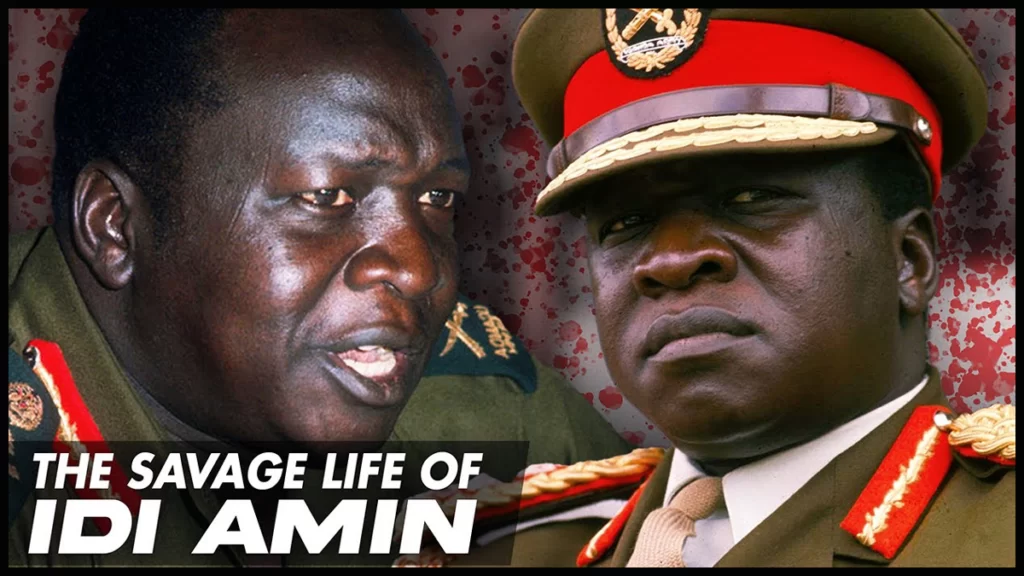
Top10 Dictators of the World
Amin’s rule was characterized by economic mismanagement, political repression. And widespread corruption, and he was eventually forced to flee the country in 1979. And when a coalition of rebel groups and the Uganda National Liberation Front invaded Uganda and toppled his regime. He lived in exile in several countries, including Libya and Saudi Arabia, until his death in 2003.
Idi Amin’s legacy in Uganda is a mixed one. While he is widely remembered as a cruel and ruthless dictator. Also some Ugandans also recall him fondly for his populist policies and charisma. However, the majority of people view him as a symbol of the atrocities committed during his rule. And the damage done to the country during his presidency.
Top10 Dictators of the World
Here are some more details about
Military career: Before becoming President, Amin was a soldier in the British colonial army. And rose through the ranks to become the commander of the Ugandan army. He was known for his strong personality and physical prowess, and was respected by many within the military.
International relations: Amin’s presidency was marked by an increasingly erratic foreign policy. And he was known for making bombastic statements and taking extreme positions on various issues. He declared himself “Conqueror of the British Empire” and severed ties with Israel. Also expelling the country’s citizens and diplomats from Uganda. He also had a tumultuous relationship with neighboring countries. And particularly Tanzania, with whom he engaged in border disputes and military skirmishes.
Personality cult: Amin cultivated a cult of personality. And his regime was marked by lavish public displays of his wealth and power. He frequently appeared in public dressed in military garb, decorated with medals and adorned with gold. He also renamed streets, buildings, and landmarks after himself, and placed his portrait in public spaces throughout the country.
All about Idi Amin (Uganda)
Human rights abuses: Amin’s regime was notorious for its widespread human rights abuses, including mass killings, torture, and forced disappearances. Many of his victims were political opponents and members of ethnic minority groups, particularly the Acholi and Langi tribes. The exact number of people killed during his regime is unknown, but estimates range from 100,000 to 500,000.
Top10 Dictators of the World
Legacy: Idi Amin’s legacy remains a contentious issue in Uganda, with some viewing him as a brutal dictator. And others seeing him as a charismatic leader who brought stability to the country. Despite the atrocities committed during his rule. And he remains a subject of fascination for many, both in Uganda and around the world. His legacy also raises important questions about the role of the military in politics. And the importance of democratic governance and human rights.
Here’s some more information about Idi Amin and his time in power: Dictator
Economic policies: During his presidency, Idi Amin implemented a series of populist economic policies aimed at improving the lives of ordinary Ugandans. These included the nationalization of foreign-owned businesses. Also the introduction of price controls on essential goods, and the establishment of cooperatives to increase food production. However, these policies were largely unsuccessful, and the country’s economy suffered as a result of corruption. And mismanagement, and declining foreign investment.
Military campaigns: Amin’s presidency was marked by a number of military campaigns, both within Uganda and against neighboring countries. He launched several invasions of Tanzania, which were aimed at annexing parts of that country. And also fought against rebel groups within Uganda, who were seeking to overthrow his regime. These military campaigns were characterized by widespread human rights abuses. Also including the killing of civilians and the displacement of entire communities.
The collapse of the regime: Idi Amin’s regime began to unravel in the late 1970s. And as a result of widespread economic collapse, political repression, and increasing opposition from rebel groups. In 1979, a coalition of rebel groups and the Uganda National Liberation Front invaded the country. And Amin was forced to flee into exile. He spent the rest of his life in various countries, including Libya and Saudi Arabia. And before finally settling in Jeddah, Saudi Arabia, where he died in 2003.
Top10 Dictators of the World
International sanctions: During his presidency, Idi Amin’s regime was subject to international sanctions. Also including an arms embargo and restrictions on trade and investment. These sanctions were aimed at pressuring him to improve human rights and restore democratic governance. However, they had little effect, and Amin’s regime continued its brutal repression of opposition and ethnic minority groups.
Impact on Uganda: The impact of Idi Amin’s rule on Uganda was profound and far-reaching. The country suffered from widespread economic collapse. And political instability, and human rights abuses, and it took many years for it to recover. Many of the effects of his rule are still felt in Uganda today, including the legacy of mass killings, torture. And forced disappearances, and the country’s political and economic struggles. However, Uganda has made significant progress in recent years. And has become a more stable and prosperous country, with a growing economy and a more democratic political system.
9. All about Muammar Gaddafi (Libya) Dictator
Muammar Gaddafi, also known as Muammar Muhammad Abu Minyar Gaddafi. And was the former head of state and the leader of the Libyan Arab Republic from 1969 to 2011.
Gaddafi was born in 1942 in a Bedouin family in the desert region of Libya. He studied in the capital city of Tripoli and later joined the military. In 1969, he led a successful coup against King Idris and established the Libyan Arab Republic. Under his rule, Gaddafi nationalized key industries, introduced a form of direct democracy, and advocated for Pan-Africanism.
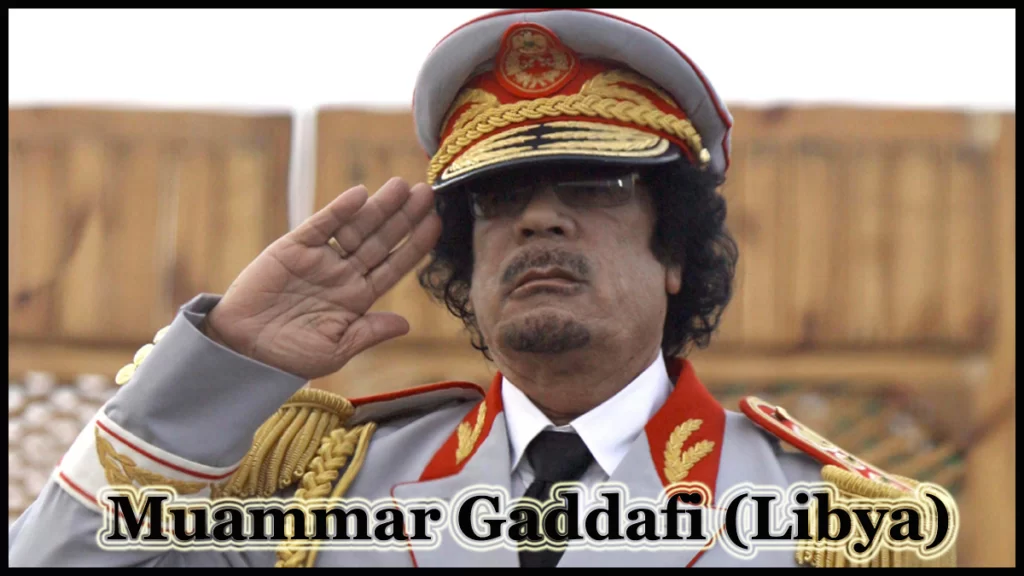
Gaddafi was known for his eccentric and flamboyant style, as well as his controversial policies and statements. He was a strong critic of Western countries and the US in particular. And he supported various revolutionary and militant groups across the world. He was also accused of violating human rights and supporting terrorism. Also which led to international sanctions and efforts to isolate Libya.
Top10 Dictators of the World
In 2011, a popular uprising erupted in Libya as part of the Arab Spring. Gaddafi responded with force, leading to a civil war and a NATO-led intervention to support the rebels. Gaddafi was eventually captured and killed by rebel forces in October 2011.
Gaddafi’s legacy in Libya is a mixed one. While he is remembered by some for modernizing the country and improving its infrastructure. Also others view him as a ruthless dictator who oppressed his own people. The aftermath of his removal from power has been marked by conflict and instability. And as various factions in the country have struggled to fill the power vacuum left by his regime.
Here’s some more information on Muammar Gaddafi: Dictator
Economic policies: During his rule, Gaddafi introduced a number of economic policies aimed at improving the standard of living for the Libyan people. These included free education and health care, subsidies for basic goods, and the creation of a welfare state. He also nationalized key industries, including oil, and used the wealth generated by these industries to fund various social programs.
Political philosophy: Gaddafi was a strong advocate of Pan-Africanism and the creation of a united Africa. He also developed his own political philosophy, which he called the Third Universal Theory. This theory combined elements of socialism, Islam, and direct democracy, and he attempted to put it into practice in Libya.
Foreign policy: Gaddafi was a controversial figure in the international community. Also known for his strong anti-Western views and support for militant groups. He was also a vocal opponent of Israel and the US. And he supported various armed groups in the Middle East and Africa. He was accused of supporting acts of terrorism, including the bombing of a passenger jet over Scotland in 1988.
Top10 Dictators of the World
Death: On October 20, 2011, Gaddafi was captured and killed by rebel forces in his hometown of Sirte. His death marked the end of his 42-year rule and the start of a new era for Libya. The circumstances surrounding his death remain controversial. Also with some claiming that he was executed without a trial, while others maintain that he was killed in the heat of battle.
Legacy: Gaddafi’s legacy in Libya is a mixed one. While some see him as a strong leader who improved the country’s infrastructure and provided for his people. Also others view him as a brutal dictator who oppressed and intimidated his citizens. The aftermath of his removal from power has been marked by conflict and instability. And as various factions in the country struggle for power and influence. Nevertheless, Gaddafi remains a significant figure in the country’s history. And his legacy continues to shape the political and social landscape of Libya.
Here’s some more information on Muammar Gaddafi’s legacy: Dictator
The Libyan Civil War: The aftermath of Gaddafi’s removal from power was marked by conflict and instability as various factions in the country struggled for power and influence. This led to the Libyan Civil War, which has lasted to this day. And has resulted in the deaths of thousands of people and the displacement of millions more.
Top10 Dictators of the World
The impact on the region: Gaddafi’s removal from power and the ongoing conflict in Libya have had a significant impact on the wider region. The country has become a major transit point for refugees and migrants attempting to reach Europe. And the conflict has attracted the involvement of various regional and international actors, leading to further instability and violence.
The role of NATO: NATO’s intervention in the Libyan Civil War was controversial. Also with some seeing it as an example of the international community’s responsibility to protect civilians. And while others view it as an example of Western imperialism and a violation of national sovereignty. The conflict has also raised questions about the effectiveness of NATO as an organization. And the limitations of military intervention as a means of resolving conflicts.
Top10 Dictators of the World
The status of Gaddafi’s family: Gaddafi’s family members have played a significant role in the post-Gaddafi era. Also with some becoming involved in politics and others being targeted by the Libyan government or international sanctions. The status and whereabouts of his son, Saif al-Islam Gaddafi, remains a topic of debate. Also with some claiming that he is in hiding while others maintain that he is in custody.
Overall, Muammar Gaddafi remains a controversial and complex figure. And his legacy continues to shape the political and social landscape of Libya. Despite the challenges and difficulties faced by the country in the years since his removal from power. Also many Libyans remain hopeful for a better future. And efforts are underway to rebuild the country and establish a stable and democratic government.
10. All about Nicolae Ceaușescu (Romania) Dictator
Nicolae Ceaușescu was a Romanian communist politician who served as the General Secretary of the Romanian Communist Party from 1965 until 1989. And as the country’s head of state from 1967 until 1989. He was one of the most prominent and controversial political figures in Romania during the 20th century.
Ceaușescu was born in 1918 in the village of Scornicești, Romania. He joined the Romanian Communist Party in the early 1940s. And rose through the ranks of the party over the next two decades. In 1965, he became the General Secretary of the Romanian Communist Party. And soon consolidated his power over the Romanian government and society.
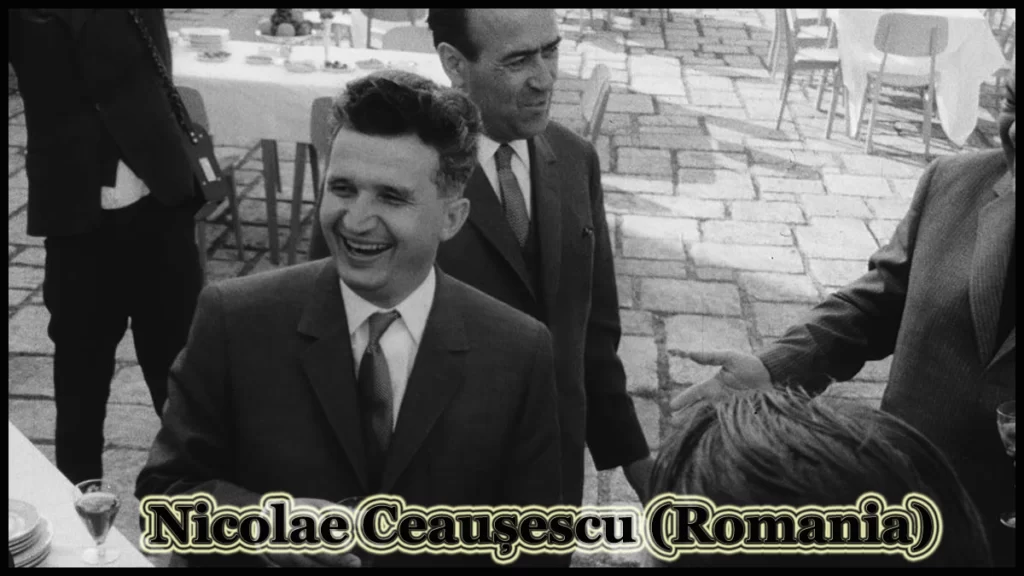
Under Ceaușescu’s rule, Romania became one of the most repressive and isolationist communist states in Eastern Europe. Political opposition was suppressed, and the secret police, the Securitate, maintained a pervasive system of surveillance and repression. Ceaușescu’s rule was marked by a cult of personality, with lavish monuments and tributes built in his honor. And he was widely regarded as one of the most megalomaniacal leaders in Eastern Europe.
Top10 Dictators of the World
In the late 1980s, as the Eastern Bloc began to crumble, Ceaușescu faced increasing dissent from the Romanian people. He responded with further repression, including a violent crackdown on pro-democracy protests in the city of Timișoara in December 1989. This sparked a wave of popular protests across Romania, leading to the overthrow of Ceaușescu in a bloody revolution in December 1989. He was executed by a military tribunal on December 25, 1989.
In the aftermath of Ceaușescu’s downfall, Romania embarked on a difficult. And often painful transition to a multiparty democracy and a market economy. Despite the challenges, Romania has made significant progress over the past two decades. And is today a member of NATO and the European Union. However, the legacy of Ceaușescu’s rule continues to cast a long shadow over Romanian politics and society. And many Romanians still remember the dark days of his dictatorship with a mixture of fear and loathing.
Also Read – Bitcoin Cryptocurrency: Everything You Need to Know About Bitcoin Cryptocurrency
Here is some additional information about Nicolae Ceaușescu and his rule in Romania: Dictator
Economic policies: Ceaușescu’s economic policies were marked by a focus on heavy industry. And the export of raw materials, particularly oil and gas. He implemented a series of austerity measures aimed at paying off Romania’s foreign debt. Also including food and energy rationing, which led to widespread hardship for the Romanian people. Ceaușescu also pursued a policy of export-led growth. Also which resulted in the neglect of the country’s agriculture sector and a shortage of food and other basic goods.
Top10 Dictators of the World
Foreign policy: Ceaușescu pursued an independent foreign policy, often at odds with the Soviet Union and other Eastern Bloc countries. He sought to establish Romania as a regional power in Eastern Europe. And sought closer ties with the West, particularly with France and Germany. Ceaușescu also supported a number of anti-Soviet. And anti-Communist movements around the world, including the Afghan mujahedeen and the Sandinistas in Nicaragua.
Family: Ceaușescu was married to Elena Ceaușescu, who held a number of high-ranking positions in the Romanian Communist Party and government. She was widely seen as her husband’s closest adviser and played a significant role in the administration of the country. The Ceaușescus had three children: Valentin, Nicu, and Zoia. Nicu Ceaușescu was a controversial figure in Romania, known for his drunkenness and corruption. And he was seen as a symbol of the excesses of the Ceaușescu regime.
Top10 Dictators of the World
Legacy: Ceaușescu’s legacy in Romania is a mixed one. While he is widely remembered as a brutal Dictator who oversaw a period of Repression and Economic Hardship. Also he is also remembered for his independent foreign policy, which helped to Establish Romania as a Regional power. Today, many Romanians view Ceaușescu as a symbol of the Country’s troubled past. And the events of 1989 continue to shape the Country’s political Discourse.
Overall, Nicolae Ceaușescu’s rule in Romania was marked by authoritarianism, repression, and economic hardship. While he left a lasting impact on the country, his legacy remains a subject of debate and controversy in Romania today.
Also Read – FIFA world cup 2030
here’s some more information: Dictator
Educational Policies: Ceaușescu placed a strong Emphasis on education, and the Romanian education system was Expanded Significantly during his rule. He believed that education was Essential to the development of the country. And he sought to make education available to all Romanians, Regardless of their social status or Economic background. Ceaușescu’s Policies had a positive impact on literacy rates and access to education. But the quality of education suffered, as the Curriculum was heavily Influenced by Communist Ideology and critical thinking was Discouraged.
Religious policies: Ceaușescu was a firm atheist, and he saw religion as a threat to the Communist state. Under his rule, the Romanian government placed strict controls on religious organizations, and the Secret Police monitored religious activities closely. Despite this, Romania is a predominantly Christian country. And the Romanian Orthodox Church remained an important part of the country’s cultural and social fabric, even during the Communist era.
Top10 Dictators of the World
Environmental policies: Ceaușescu’s economic policies placed a heavy emphasis on industrialization, and this had a significant impact on the environment. The country’s forests were heavily depleted, and air and water pollution became widespread. Ceaușescu was dismissive of environmental concerns. And he did little to address the environmental degradation that took place during his rule.
End of the regime: Ceaușescu’s downfall was swift and dramatic. Popular protests erupted across Romania in December 1989, and Ceaușescu was arrested and tried by a military tribunal. He was convicted of crimes against the state and executed by a firing squad on December 25, 1989. The fall of Ceaușescu marked the end of the Communist era in Romania. And the country began a process of political and economic reform.
Top10 Dictators of the World: Conclusion
In conclusion, Nicolae Ceaușescu’s rule in Romania was characterized by authoritarianism, repression. And economic hardship, but also by a focus on education and a unique foreign policy. His legacy remains a subject of debate and controversy. But it is widely agreed that his rule had a lasting impact on Romania and its people.
Also Read – Mindful Living and Mindfulness Meditation
Top10 Dictators of the World

2 thoughts on “Top10 Dictators of the World”